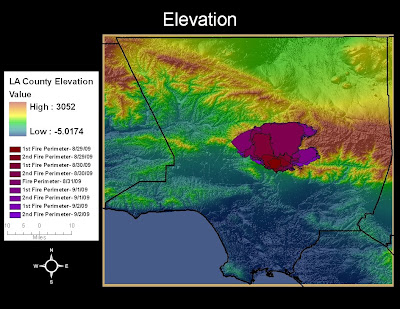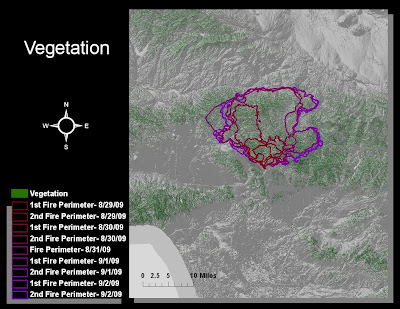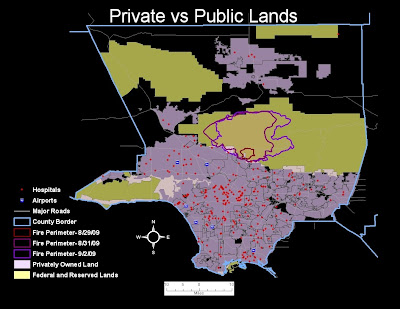


The climatic conditions of the Southwestern United States are that of a desert- dry land, arid atmosphere, and overall minimal precipitation. Southern California, in particular, primarily has a Mediterranean climate, which means that it is cold and wet in the winter, but the summers are very hot and dry, and the vegetation is dominantly Chaparral. The dry summer climate and Chaparral that can easily withstand the dry conditions both contribute to the many fires that start in the Southern California region each year (World Wildlife Fund). This past August, the peak of the hot season, firefighters faced a blaze that was so difficult to handle, with the Station fire, that federal lands had to be sacrificed in order to protect human life and possessions.
Although the cause of the fire was arson, according to the LA Times online newspaper, the climatic conditions of the region supported the fire's growth, and made it terribly difficult to contain. "On Tuesday, the backfire, or controlled burn, was canceled because of heavy winds, temperatures in the low 90s and relative humidity around 10%" (Lopez). Also, while firefighters desperately tried to contain the flames from spreading "the fire....sent plumes of thick smoke spiraling as much as 20,000 feet into the air....creating its own wind patterns, [and] making it unpredictable" (Marciano). Overall, the weather conditions in fact made it worse for the firefighters to complete their task.
Due to the Chaparral's ability to burn easily, and the build up of the vegetation from decades of no fires burning in that specific area, the Station fire had plenty of fuel to not only last, but to grow immensely in a very short time span. "Efforts [by the firefighters] have been impeded by the extremely difficult terrain, vegetation that has not burned for over four decades and hot and dry weather conditions" (AHN). Refer to the map of the distribution of vegetation in Los Angeles County; this map shows the geographical relationship between the spread of the Station fire from August 29 to September 2 and the location of vegetation in that area. Notice that there is a significant amount of vegetation to the north and east of the origion of the fire, while, in contrast, there is very little vegetation to the south. The spread of the fire follows the path presented by the vegetation, and travels due north and east during its initial spread.
The firefighters main concern while combatting the flames were to protect the neighboring population and keep major highways open by prioritizing the containment of the fire on the south and west ends. According to the LA Times "Most of the fire's growth Thursday took shape on its eastern flank", and "on thursday, around noon, officials closed southern part of the Angeles National Forest" (Blankstein). Even though the Angeles National Forest is located to the north of the origin of the fire, officials were determined to deter the fire from the population and sacrifice the national forest, which is on federal lands. Notice on the "Private vs Public Land" map the spatial relationship between the private land held by the population and public land that belongs to the government, and both of their relationships to the spread of the fire. As the map shows, over time the fire grew away from private lands, represented by the pink shade, and overtook parts of property that is owned by the government, represented by the yellow shade.
Althought the weather conditions, vegetation, and terrain made it difficult for the fire fighters to contain all perimeters of the fire, the heros did receive some help from unsuspecting sources in detering the flames away from private property. While the vegetation fueled the fire's great spread, it also pulled the fire to the north and east, away from the population. Also, "most of the fire's growth Thursday took shape on its eastern flank....where firefighters battling the blaze faced treacherous conditions, including steep terrain and rolling rocks (Blankstein). The terrain that made it so demanding to contain the flames was mainly located on the eastern side of the original fire, which fortunately was also away from residential areas and major roads.
References
AHN. "Update: Angeles National Forest Fire Now Over 140,000 Acres; Emergency Declared In San Bernardino County." Inquisitr September 2, 2009. Web. 24 Nov 2009. http://www.inquisitr.com/35595/update-angeles-national-forest-fire-now-over-140000-acres-emergency-declared-in-san-bernardino-county/.Blankstein, Andrew; Bloomekatz, Ari; and DiMassa, Cara. "Station fire an act of arson, sheriff's officials say." Los Angeles Time (September 4, 2009): n. pag. Web. 24 Nov 2009. http://articles.latimes.com/2009/sep/04/local/me-fire4?pg=2.
Lopez, Robert and Winton, Richard . "Containment of Station fire slows amid unfavorable conditions." Los Angeles Time/ Local (September 9, 2009): n. pag. Web. 24 Nov 2009. http://latimesblogs.latimes.com/lanow/2009/09/containment-station-fire-slows.html.
Marciano, Rob, Chad Myers, John Torigoe, and Stephanie Chen. "Angry fire' roars across 100,000 California acres." CNN.com/US (August 31, 2009): n. pag. Web. 24 Nov 2009. http://www.cnn.com/2009/US/08/31/california.wildfires/index.html#cnnSTCPhoto.
World Wildlife Fund, . "California Chaparral and Woodlands." Wild World Ecoregion Profile. 2001. National Geographic, Web. 24 Nov 2009. http://www.worldwildlife.org/wildworld/profiles/g200/g121.html.










